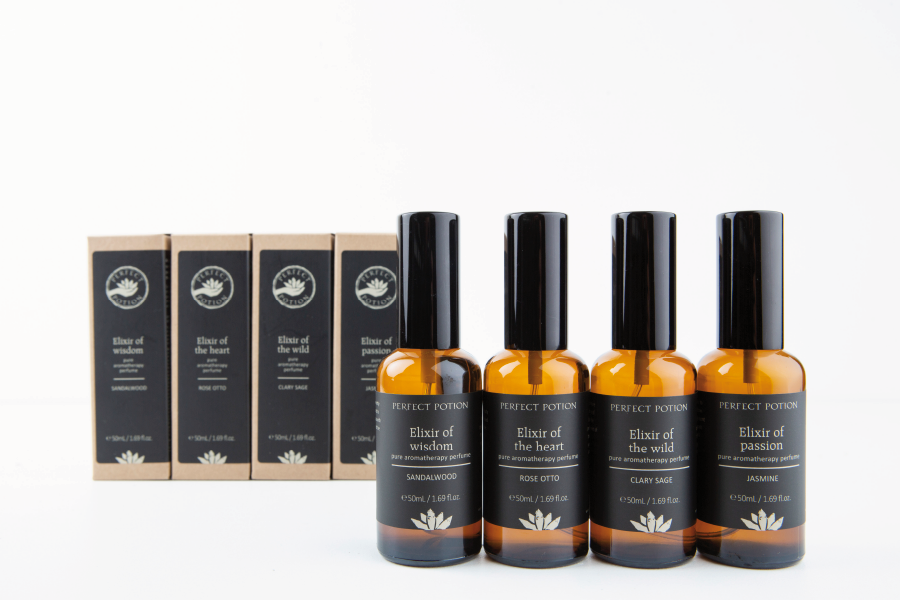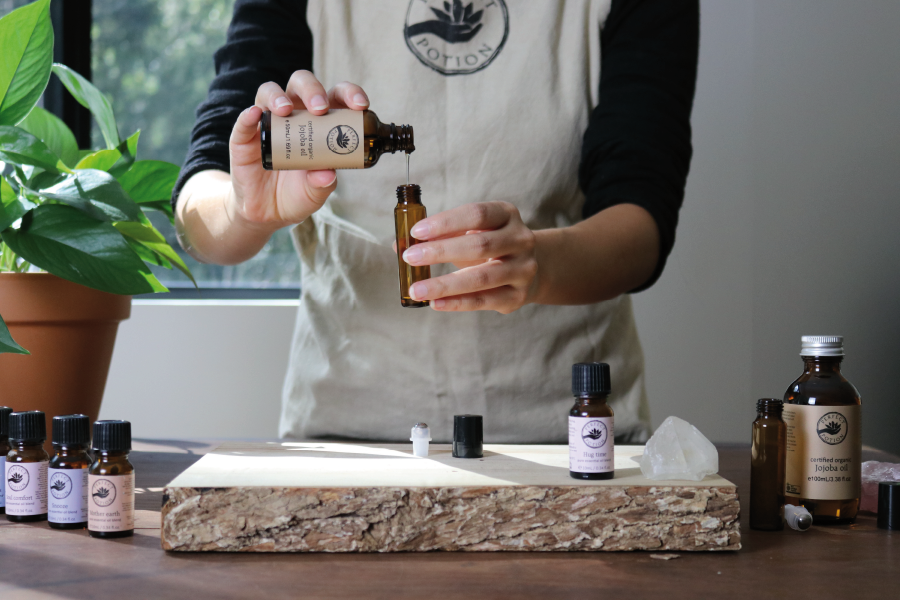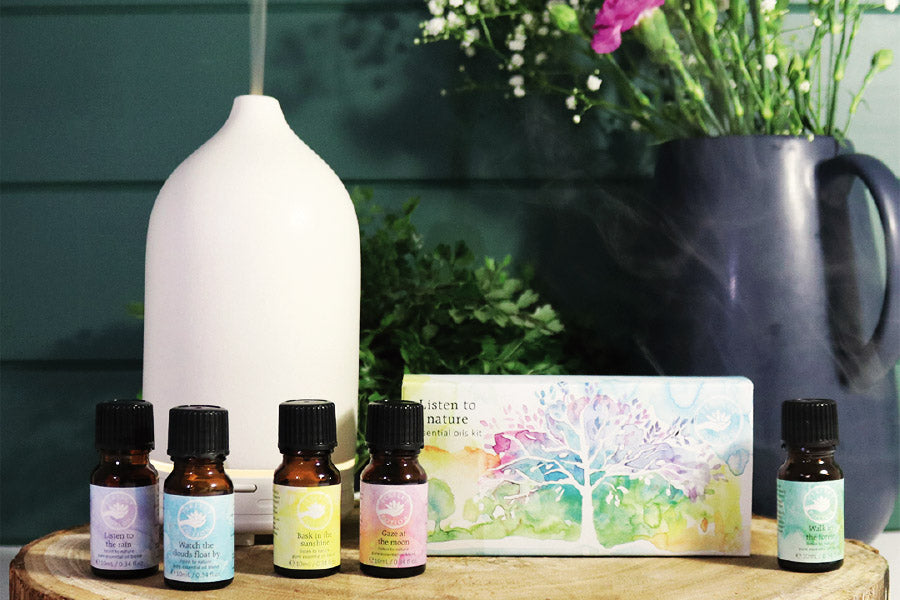What is an elixir?
Elixir
- An alchemic preparation formerly believed to be capable of transmuting base metals into gold, or of prolonging life: elixir vitae or elixir of life.
- A sovereign remedy; panacea; cure-all.
- The quintessence or absolute embodiment of anything.
– Macquarie Dictionary, 2003.
The art of perfumery is like combining colours on a pallet. Although blending essential oils is a fun and playful aspect of aromatherapy, it is also an art and science. Like any art, it requires a balance of practice, skill and imagination.
Creating perfumes is not just about creating a mixture of pleasant smelling aromatics. It is about balancing the dualities of intellect and intuition; the conscious and unconscious; the conventional and unconventional; complexity and simplicity.
A perfume must meet a number of technical requirements. It must be sufficiently strong. It must be diffusive. It must be persistent, and it must retain its essential character throughout its period of evaporation. It must also be chemically stable as an end product.
Discover how to maintains heart while avoiding synthetics to keep the true essence of nature alive in your favourite perfume creations…

How to create your perfume elixir
Define the objective of your perfume
Step one is to clearly define the objective of the perfume you are creating. The purpose of forming the objective is to identify the smell of the perfume before running off to the lab to start choosing raw materials. This is the most difficult part of the creative process and requires the greatest discipline. Anything less than 50 words is insufficient.
Select your essential oils
Basic essential oils: The first group of oils are the subject – the noun that forms the main theme of the objective and will be reflected in the title.
Modifier essential oils: The second group of oils are the adjectives. Modifier oils are defined as those oils that smell different from the subject (the basic essential oils). Modifiers will add the style, character, naturalness, freshness or diffusion to the perfume.
Blender essential oils: The third group of oils are the blenders. These are the conjunctions; the words that connect the nouns and aid the flow of words. When two materials of different odour notes are blended there should be a harmonious transition from one note to another. This is the job of the blenders, whose role it is to smooth over or bridge the differences.
Fixative essential oils: Fixatives are the materials that form the prepositions and their objects in the sentence. Fixatives are materials that fix the fragrance or note in time or place. Fixatives in perfumery are often described by default as the materials that make a perfume last longer. Dowthwaite states a far better way to think of a fixative is as a material that provides the setting for the perfume – materials that complete it, that make it perfect and whole. They generally have a lower impact on the blend. In term of odours, they will ideally be materials that display some of the characteristics of the basics and modifiers and have the desired dry out of the perfume.
The blending process
Make sure you add drops from a standardised dropper or pipettes.
Step 1: Form the basic structure or the heart
In this step, you select only two or three materials from the list of ingredients. If you are not sure where to start, mix equal proportions, smell and evaluate the combination. It should be apparent if one of the ingredients is incorrect, over- or under-dosed, and then simply replace, increase or decrease each component until the required effect is obtained. This basic mixture may form an accord in which synergy or harmony exists.
Dowthwaite warns against adding too many materials too soon as it will make it difficult to track future problems such as lack of diffusion or disharmonies.2
Step 2: Modifying step – decorating the basic structure
In this step, choose just one material from the list of modifiers. It is best to start with modifiers in order of importance, which may well be in the order in which they occur in the written objective. The perfumer must choose one material for fresh, one for clean etc. As modifiers tend to be the highest impact materials, they should be added drop by drop until the required effect is achieved. Perfumers should smell each addition before moving on to the next modifying material and must start again in the case of an overdose. Each sample should be labelled and kept for reference. If appropriate, the perfumer should rearrange the order of adding the modifiers. It is imperative to take notes at each step so that you can learn from each step.2
Step three: Blending step – harmonise the composition
You should choose one material from your blender list. Add blenders drop by drop and mix and smell until the required smoothing effect is obtained. For example, lavender has a fresh note that goes well with citrus, green or herbal notes. It has a floral and slightly woody background which means that it acts as a bridge between fresh top notes and the floral heart of many perfumes.2
Step four: Fixation step – adding background and depth
The perfumer should now pick one or two fixatives. Although fixatives are usually base notes they will be present throughout the life of the perfume. They add depth to the composition, transforming a flat two-dimensional smell to a perfume with a third dimension. Fixatives should be added to the blend drop by drop, then mixed and smelled until the required effect is achieved. If you overdose your blend with fixative it may cause the blend to become flat and lifeless.2
Example - Sal's [Limited Edition] Elixir of the Earth
Sal explains how he used this process to create Elixir of the Earth.
Description
Elixir of the Earth epitomises the scent of vetiver – the scent of mother earth. The scent of vetiver is very complex – it has a heavy, earthy, spicy, musty, smoky and woody aroma. I find the scent of vetiver nurturing, nourishing and revitalising. At the same time, it is mysterious and grounding. The scent of Elixir of the Earth has to reconnect us to the vitality of mother earth.
Select your essential oils
Basic essential oils
The heart and soul of Elixir of the Earth is vetiver. To enhance the earthy notes of vetiver I added buddha wood, carrot seed and patchouli.
Modifier essential oils
To enhance the natural earthiness of vetiver I added galbanum which provides a delightful green note. The herbaceous floral note of clary sage enhances the mystery and intrigue, while a dash of ginger and clove bud provide a delicate warm and spicy note. To this, I added rose absolute which further enhances the warm and nurturing qualities of this blend – but not too much!
Blender essential oils
While bergamot, lemon and sweet orange are often added as top notes, in this case, they are used as blenders. This means that they provide balance and harmony to the rich earthy aromas used in this blend. A dash of lavender provides further harmony and balance to this blend.
Fixative essential oils
You could say that vetiver is the perfect fixative on its own; however, I decided to add some amyris, Santalum spicatum and benzoin which helps Elixir of the Earth to last longer without impacting too much on the overall aroma of the perfume.
Advice
Remember, as highlighted by Mandy Aftel, who gives us some excellent advice in her book Fragrant in the chapter entitled – The zen of perfume making; it is important to have an orderly system as the narcotic sensual influence of smelling essential oils can make it difficult for you to keep track of what you are doing. Here are the principles that she follows:3
- the entire process should be beautiful
- adhere to a strict budget
- write down everything you do while you are blending
- experience the perfume on the skin. (However, I always suggest giving the final perfume some time to rest for up to 48 hours before applying to the skin!)
- plan on failing and redoing
- be real – let go (sometimes a blend will just not work out)
- spend money to create something good
- creating perfume mirrors life
Perfect Potion Aromatherapy Perfume Elixirs
Perfect Potion’s Pure Aromatherapy Perfume Elixirs are alchemical creations for heart and soul.
|
These elixirs are the quintessence and embodiment of nature. They represent a desire to return to nature, authenticity, health and wellbeing and a more holistic way of living. Scent has the invisible power to penetrate our consciousness, to shift our awareness fully into the present moment whilst simultaneously touching us, moving us and transporting us to ethereal, hidden realms of memories and sensations. Mist Elixir of Passion to evoke the desire and sensuality, or breathe in the essence of Elixir of the Heart for romance and enchantment. To encapsulate such magic and allow us to breathe in worlds of experiences in a single spritz, it takes a poetic, almost spiritual process.
|
BLOG BY

By Salvatore Battaglia
Aromatherapist | Owner & Founder of Perfect Potion
References
-
Jellinek S, Calkin R. Perfumery – Practice and Principles. John Wiley & Sons, USA, 1994.
-
Dowthwaite S. The grammar of perfumery.Perfumer & Flavorist. October 2004; 29:76-87.
-
Aftel M. Fragrant – the secret life of scent. Riverhead Books, New York, 2014.




